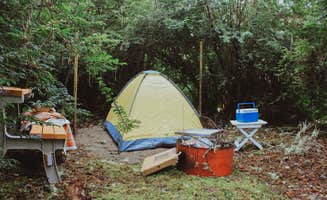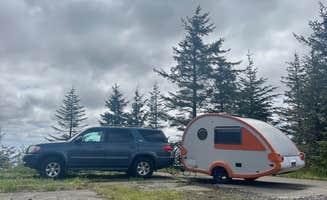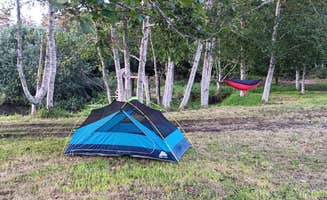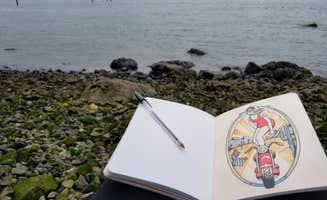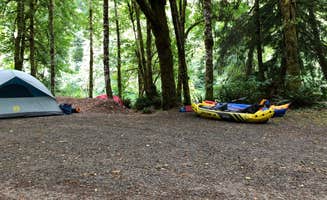Tent camping near Loomis, Washington typically requires navigating gravel forest roads with elevations ranging from 1,500 to 3,500 feet, primarily within Department of Natural Resources (DNR) managed lands. These primitive sites experience significant temperature variations, with summer days reaching 85°F while dropping to 45°F at night. Seasonal closures occur during winter months when snowfall makes access difficult between November and April.
What to do
Fishing opportunities: Western Lake provides stocked trout fishing during spring and summer months. A camper noted, "When I was there, there were a couple of beaver working at the head of the lake. A quiet location and if you go farther up the road there is a viewpoint that lets you see clear to the coast on a sunny day."
Wildlife viewing: The forest roads around Road to Snag Lake - Dispersed camping areas offer excellent wildlife watching, particularly for rabbits and birds. One visitor shared, "Amazing views and complete silence! Tons of rabbits and wildflowers. Can't recommend this place enough for a dispersed site."
Hiking: Forest service roads provide informal hiking routes with elevation gains offering valley views. From the higher campgrounds, trails lead through alder and maple forests. A camper at Sherman Valley- State Forest mentioned, "The campground is located in Capital Forest which is home to lots of hiking, mountain bike, equestrian, and ATV trails."
What campers like
Concrete pads for flat tent setup: Several dispersed sites along forest roads contain concrete pads from former structures that make ideal tent platforms. A camper reported, "Very quiet. Spots for van or tent are between radio/cell towers, so doesn't feel like wilderness but there is the potential for spectacular views if the clouds clear. Cement pad makes a flat tent site."
Privacy between sites: Western Lake Campground offers more separation between campsites than other nearby options. The camping area remains underutilized even during summer months, with a visitor noting, "Easy to get to and a beautiful lake. A quiet location and if you go farther up the road there is a viewpoint."
Cell service availability: Unlike many remote camping areas, the dispersed sites near radio towers provide excellent connectivity. One camper stated, "Secluded and great view, other than the cell towers. At least I have great T-Mobile signal. Concrete pads at multiple sites. Nobody drove by all night."
What you should know
Discovery Pass requirements: Washington State Discovery Passes are mandatory for parking at DNR sites with enforcement checks occurring regularly. One camper at Road to Snag Lake - Dispersed clarified, "This site is listed as free, but there is a sign at the entrance for needing a discovery pass to use the site. Visit their website for payment options. You have to print the pass or write the transaction number on a paper and on your windshield."
Road conditions: Access requires vehicles with adequate clearance on steep forest roads. A visitor explained, "The road getting here is a bit rough with lots of washboard, steep grades and rocks. But it's fun. No amenities, obviously, but there is a concrete pad from an old structure you can park on."
Limited facilities: No potable water sources exist at most sites, requiring campers to bring all water needed. Most dispersed sites lack toilets entirely, while established campgrounds may have basic pit toilets. Proper waste disposal planning is essential as trash services aren't available at remote locations.
Tips for camping with families
Best tent camping sites for children: Areas near Clatsop State Forest Gnat Creek Campground provide safer terrain for families, though they require driving further from Loomis. A visitor shared, "Each site has a picnic table and fire pit. Walk in tent camping only, or you could park your van in the parking lot. Sites are among the trees and you can hear the creek from your tent."
Educational opportunities: Several camping areas connect to fish hatcheries that offer informal educational experiences. One camper noted, "We also took advantage of where we wound up and did a short hike which led to a fish hatchery."
Weather preparation: Temperature swings of 30-40 degrees between day and night require appropriate clothing and sleeping gear for children. At higher elevation sites, a camper observed, "Unfortunately we could see nothing but clouds this visit, but I would still come back! Not much for tent camping but better for cars or campers and very bumpy on the way up."
Tips from RVers
Access limitations: Most dispersed camping locations near Loomis have restricted RV access due to narrow roads and tight turning areas. One camper at Rose Creek Retreat advised, "Also there is a sign that says no RVs, campers or trailers. I was a bit nervous that I would be asked to leave in my van, but never saw a ranger or anyone official."
Level parking concerns: RVs should prioritize sites with concrete pads when available, as forest terrain often features significant slopes. A visitor recommended, "Other sites have solid pack gravel covered by grass," which provides more stable surfaces for parking larger vehicles.
Seasonal considerations: Spring access often involves navigating muddy conditions while summer creates dusty roads. Smaller trailers under 18 feet have better success accessing the more remote camping areas when conditions permit.


